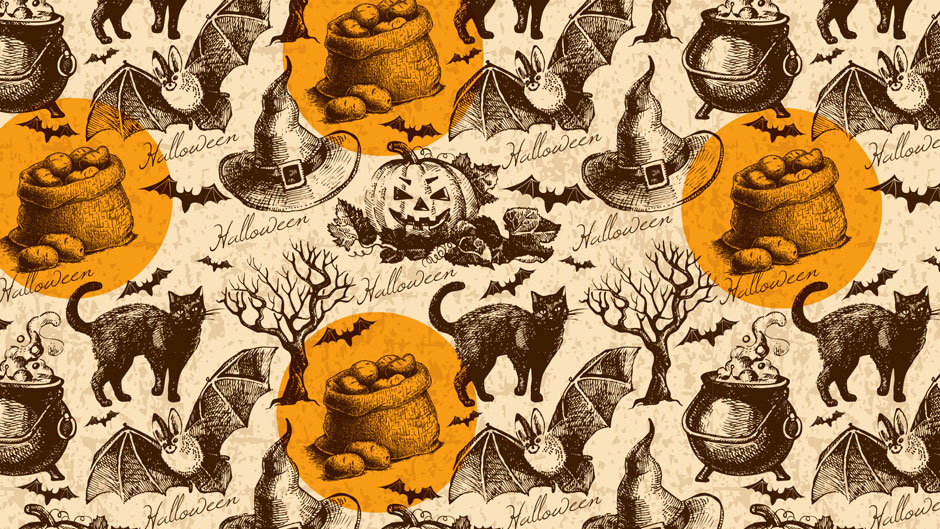Halloween. The Oct. 31 holiday conjures up notions of goblins, ghouls, and spirits; masks and disguises; jack-o’-lanterns; and trick-or-treating, even bobbing for apples and carving them to know your fortune. Each and every aspect is rooted in the ancient Celtic holiday of “Samhain” (SAH-win)—literally “Summer’s End.” The Celts lived in what is today Ireland and celebrated the last day of October as the beginning of the new year. Indeed, it was their most sacred day of the year.
And while pumpkin is the irrefutable king of Halloween today, the holiday in the United States owes more to the potato—and a rotten one at that.
The “Great Irish Famine” began in 1845 with a blight that destroyed the leaves and tubers of the potato—the staple of the Irish diet. The devastation persisted for nearly a decade. With nothing to eat and no help from England—Ireland was a colony of England at the time—hundreds of thousands of peasants who practiced a Catholicism infused with their Celtic ancestors’ paganism abandoned their tiny cottages and immigrated in massive numbers to the United States.
“In the mid-1840s with the potato famine, the scale of Irish immigration to the United States increases dramatically, and the Irish throughout the mid-century decades become the dominant immigrant group to the country,” explained Max Fraser, an assistant professor in the University of Miami College of Arts and Sciences Department of History and a scholar of U.S. labor, cultural, and political history.
“These immigrants—overwhelmingly poor and working-class—received a largely hostile reception from the predominantly Protestant, Anglo-American established political culture that existed in the U.S. at that time,” Fraser said. “They looked down at the Irish immigrants for their Catholicism and viewed them as a foreign threat, sensing that they owed their loyalties first and foremost to the Vatican and to Rome and were therefore a threat to the American culture.”
As for virtually every other ethnically defined immigrant group to the U.S. at any time—and possibly particularly so for these unskilled and much-demeaned Irish—religious and cultural practices were essential to their survival, according to Fraser.
“Ethnic identity became a sole refuge for the non-native immigrant, a haven and cultural space of refuge,” he said. He noted, too, that the U.S. at the time was experiencing a surge of nativism, protecting the interests of the established inhabitants against those of newcomers—though the “inhabitants” themselves had arrived not long before.
“The religious issue became a battleground, a way of targeting Irish immigrants and communities,” said Fraser, noting the numerous acts of violence directed at Catholic churches and places of worship in the 1840s and 1850s. The Philadelphia Nativist Riots, led by anti-Catholic nativists and where at least 15 rioters and soldiers were killed, were among the most infamous.
The Celtic worship of Samhain began more than a thousand years ago in Ireland. On the last day of October—the midpoint of the year that marked the end of summer and the beginning of winter—they lit bonfires and dressed in disguises to keep the evil spirits away. For it was on this night that the Celts believed the “veil between the worlds”—that of the living and of the dead—was the thinnest and that spirits could walk on Earth.
The fires were meant to keep the evil spirits at bay and the disguises—well, if you were wandering home in the dark cloaked in an animal skin and bumped into a spirit, they just might mistake you for one of their own. The worshippers even hallowed out turnips and carried a spark of the bonfire inside to light their way home.
St. Patrick and other Catholic priests did their best to suppress these pagan beliefs, but the folk traditions persisted, and ultimately suppression gave way to syncretism—the beliefs were fused. Catholicism in Ireland reflected an eclectic mix of Christian and pre-Christian customs, and by the 8th century, the Catholic church was celebrating “The Eve of the Feast of All Hallows,” to which was later added “All Hallows’ Day/Hallowmas” or “All Saints Day” on Nov. 1 and “All Soul’s Day” on Nov. 2.
In the Irish immigrants’ new home in the U.S., pumpkins were far more plentiful than turnips, and the orange winter squash with its slightly ribbed skin—with a flickering candle inside—became commonplace in windows on this late fall night.
Halloween continued to catch on. By the early 1900s, trick-or-treats, haunted houses, or costume parties were common in many neighborhoods. Families made their own Halloween outfits, mostly designed to conceal the wearer’s identity and to evoke spooky images of witches, cats, and the moon.
The holiday took a new turn in the 1920s and 1930s with the rise of radio, film, and the mass entertainment industries.
“These new industries drew on a variety of vernacular folk-ethnic traditions—and yet also, slowly and over time, worked to eradicate them,” Fraser pointed out. “They were transforming American culture, undermining the persistence of various ethnic parochialisms as a national mass culture began to emerge during these years.
“Halloween, as is the case with other holidays, increasingly becomes disconnected from those folk traditions in any identifiable way. What emerges instead is a holiday of the marketplace—whether it’s in candy production, or Hollywood's mass production of film entertainments in the horror movie genre, or dress-up culture,” he said.
The release in 1937 of Disney’s first fully animated feature film, “Snow White and the Seven Dwarfs,” served to heighten Halloween’s commercialism.
With his theatrical design company floundering during the Depression years, Ben Cooper assumed control of the firm that held a license with The Walt Disney Company to mass produce costumes based on popular characters in its films.
The cheaply priced masks and costumes of Snow White, Grumpy, Dopey, Sleepy, and Sneezy were soon available in retail stores. And Halloween, which had grown increasingly popular during the Depression, was now a mere skeleton of its original sacred self.

